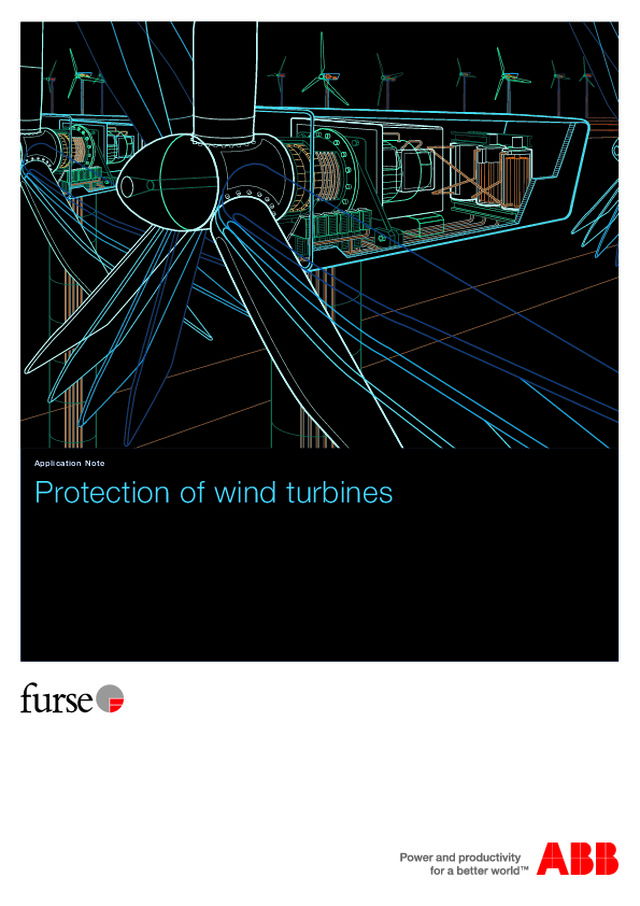Shopping Cart


Protection of wind turbines - Furse - 2015
Protection of wind turbines
Protection of wind turbines Application Note
Protection of power and data/signal/telecoms lines in wind turbines 2 AN015 | Application Notes - Protection of Wind Turbines Wind turbines contain a substantialarray of electronic systems, includingpower, control, and telecoms systems, which are all vulnerable to damage from partial lightning currents and transient overvoltages. Partial lightning currents can enter a wind turbine following a lightning strike either to the blades, tower, or to incoming/outgoing power & data/signal/telecoms lines. Transient overvoltages can be electromagnetically induced onto the turbine’s electrical network as a result of power switching or nearbylightning activity. These overvoltages can result in severedamage to electronic circuitry and need to be effectively countered to avoid expensive downtime and repair/maintenance costs. Zonal approach to protectingelectronic systems Electronic systems in wind turbines are sited in a number of locations: – The nacelle (generator, pitch & yaw controls and motors, sensor/actuator controls) – The turbine base (frequency converter, LV switchgear & transformer, control system) – The local HV transformer station For all of these locations, external and internal Lightning Protection Zones (LPZ) have been defined, in accordance with the principles established in BS EN/IEC 62305 & IEC 61400, to protect key equipment (see Table 1). This zonal approach regulates the Classification of SPD required (Type 1 or Type 2 mains and Type B or Type C data/signal/telecoms) to protect equipment in line with its voltagewithstand and operating characteristics. Power line protection Lightning current SPDs (Type 1) are required at boundaries between LPZ 0 and LPZ 1, to counter partial lightning currents, with transient overvoltage SPDs (Type 2) required between LPZ 1 and LPZ 2, to protect critical equipment within the wind turbine (see Figure 1). Furse ESP combined 1+2 SPDs for 690 V systems and combined 1+2+3 SPDs for 230 V / 400 V systems prove highly suitable for protecting wind turbines. As combined SPDs they offer both low let-through voltage and full mode protection between all sets of conductors, for optimum surge protective performance to minimum LPZ 2. SPDs should be installed on the line side, as close as possible to the equipment being protected. Where connected downstream equipment is greater than 10 m away, a second SPD should be installed at the subsequent equipment (in line with the guidance in DD CLC/TS 50529-22:2010). 690 V circuits require a SPD specific forthe voltage level, such as the FurseESP 690/12.5/WT or higher surge current ESP 690/25/WT SPDs. Power lines at 230 V / 400 V AC andalternative voltages should also be protected by a suitable Furse SPD (See Table 2). Where the main HV transformer is housed separately from the wind turbine, ncoming/outgoing linesfrom both the wind turbine and the transformer station should be protected - LPZ boundary LPZ 0 to LPZ 1 (control system electronics where installed to minimum LPZ 2). Table 1: Wind turbine equipment requiring protection Equipment Typical Location Lightning Protection Zone (LPZ) Generator Nacelle LPZ 0 to LPZ 1 Motor (yaw/pitch) Nacelle LPZ 0 to LPZ 1 Auxiliary circuits (aviation warning lights/anemometer) Nacelle LPZ 0 to LPZ 2 Frequency converter Turbine base LPZ 0 to LPZ 2 Wind turbine control system Turbine base LPZ 0 to LPZ 2 LV side of transformer + switchgear Turbine base/ Transformer station LPZ 0 to LPZ 1 HV side of transformer Turbine base/ Transformer station LPZ 0 to LPZ 1 Transformer station control systems Transformer station LPZ 0 to LPZ 2
Application Notes - Protection of Wind Turbines | AN015 3 Table 2 : SPD selectionLocation SPD required Generator (690 V) ESP 690/12.5/WT or ESP 690/25/WT Frequency converter (690 V) ESP 690/12.5/WT or ESP 690/25/WT Transformer (690 V) ESP 690/12.5/WT or ESP 690/25/WT Control system (230 V) ESP 240 D1 or ESP 240 M1 Aviation warning light (230 V) ESP 240 D1 or ESP 240 M1 Hub control (230 V) (4-20 mA loop) (RS 485) ESP 240 D1 or ESP 240 M1 ESP SL30L/4-20 ESP SL06 Anemometer (24 V) ESP SL30 Modem ESP TN SPD SPD SPD SPD SPD SPD SPD SPD SPD SPD SPD SPD SPD SPD SPD SPD SPD SPD SPD SPD SPD SPD SPD SPD SPD SPD LPZ 2 LPZ 1 LPZ 0 LPZ 1 LPZ 2 LPZ 1 LPZ 0 Gearbox Power line 690 V Power line 230 V Data line Hub Transformer Power line SPD 230 V Power line SPD 690 V Data line SPD 10 metres Frequency converter Modem Auxilliary transformer 690 V to 230 V Wind turbine control system Control cabinet Anemometer Aviation warning lights Generator Data/signal/telecoms line protection Figure 1 also highlights the points at which Furse SPDs should be installed to protect data, signal and telecommunications lines. A wide range of Furse SPDs is available for this purpose, including Furse ESP SL Series, or Furse ESP D, E, H Series. The SPD selected should be compatible with the system to be protected, and must offer sufficient protection to reduce overvoltages below the immunity threshold of the protected equipment. The SPD must not impede system performance and must have the ability to survive repeated transients. Control equipment at the wind turbine ismost likely to be networked to remotelocations and, following BS EN/IEC 62305, protection at these remote points should also be risk assessed. Figure 1: Application of SPDs within a typical wind turbine environment
© Copyright ABB 9AAK10103A5593 5 Electronic Systems Protection Equipotential bonding and transient overvoltage surge protection Electronic Systems Protection Equipotential bonding and transient overvoltage surge protection Contact us ABB FurseUK OfficeWilford RoadNottingham NG2 1EBTel: +44 (0) 115 964 3700 Fax: +44 (0) 115 986 0071 Sales Tel: +44 (0) 333 999 9900Sales Fax: +44 (0) 333 999 9901E-Mail: [email protected] www.furse.com Note: We reserve the right to make technical changes or modify the contents of this document without prior notice. With regard to purchase orders, the agreed particulars shall prevail. ABB AG does not accept any responsibility whatsoever for potential errors or possible lack of information in this document. We reserve all rights in this document and in the subject matter and illustrations contained therein. Any reproduction, disclosureto third parties or utilization of its contents – in whole or in parts – is forbidden without prior written consent of ABB AG. Copyright © 2015 ABBAll rights reserved